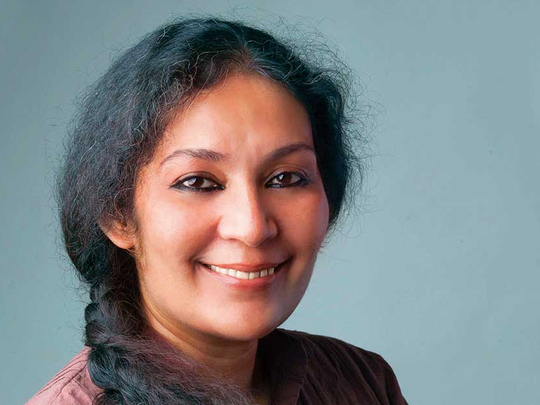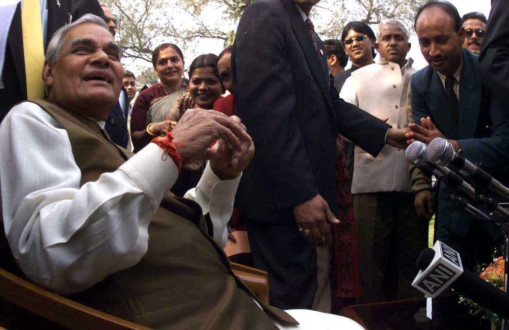
By Saba Naqvi, Westland, 288 pages, Rs599
The world was reeling in shock. The sight of planes flying into the twin towers, followed by balls of fire and smoke would henceforth define global terrorism. Just a few months after the 9/11 attack on New York City, on December 13, 2001, five men made an attempt to enter the Indian parliament. Fourteen people died including the intruders, six Delhi police personnel, two parliament security personnel and a gardener.
I reached parliament that day but found it under siege and stood outside the security cordon, hearing distant gunfire and watching the huge security build-up.
The government swiftly blamed terror groups, Lashkar-e-Taiba or LeT and Jaish-e-Mohammad (the one led by Masood Azhar who had been released in Kandahar) and demanded that Pakistan act against the leaders operating from that country. On its part, Pakistan claimed that the attack on parliament was an operation mounted by Indian Intelligence agencies to defame the legitimate movement for freedom in Kashmir.
Within two days of the attack on Indian parliament, there were indications of a war-like situation between India and Pakistan. The Cabinet Committee on Security (CCS) met and initiated the biggest mobilisation of troops on the border since the 1971 war with Pakistan. Operation Parakram was launched on December 15, 2001, and lasted 10 months. The result: over four hundred Indian soldiers were dead, many in landmine explosions, even as the world watched helplessly, dreading a full-blown war between two nuclear-armed nations. Subsequently, the government stated in parliament that Operation Parakram had cost the nation a whopping Rs800 crores. Most military and defence experts would critique the operation as a costly misadventure that served no real purpose.
This, therefore, was the backdrop to the politics that unfolded in 2002. By the time Operation Parakram had been initiated, Narendra Modi was chief minister of Gujarat for over two months; the US had begun its ‘War on Terror’; every Indo–Pak peace initiative had failed spectacularly; and Atal Bihari Vajpayee continued to dodder between poor health and moments of lucid brilliance.
The BJP found itself facing two state elections — first in Uttar Pradesh at the beginning of the year, a state that had catapulted the party to national prominence at the time of the Ram temple movement, but where it had subsequently lost ground.
The quick sequence of events that followed is known. The BJP fared very poorly in Uttar Pradesh, down to seventy-seven seats in a House of 403, the party was in the third place after the Samajwadi Party (SP) and Bahujan Samaj Party or BSP.
The poor result was seen as a personal drubbing for Vajpayee. Uttar Pradesh has the highest percentage of Brahmins in the country, about 10 per cent of the electorate of the state. Much was made of the fact that the Brahmin prime minister had failed to draw in the pundits of the Hindi heartland. Simultaneously, the verdict was also the rejection of the Ram mandir card, which the VHP had continuously worked on, even as the BJP was ambiguous about its efficacy.
Given the backdrop, it was also the rejection of a Hindu-Muslim binary that was in theory meant to work for the BJP; in contrast, parties that highlighted caste did much better in UP back in 2002.
Then events took a bloody and dramatic turn. On February 27, 2002, two days after the UP results, more than a hundred kar sevaks were returning to Ahmedabad on the Sabarmati Express, after taking part in a religious mobilisation in Ayodhya. When the train stopped at Godhra, it was alleged that a few kar sevaks had got into an argument with Muslim vendors on the station. Suddenly, a few bogeys of the train were set on fire, resulting in the horrific death of fifty-eight passengers. What followed thereafter is known as the Gujarat riots: Muslims in the state were systematically targeted and killed. India, and particularly Gujarat, wasn’t new to communal violence, but what was different in 2002 was live television. It was the first televised communal riot.
There is no purpose served here to get into the details of the riots on which several books have been written, documentaries made, and cases continue to be fought. But the riots had implications for Prime Minister Vajpayee whose entire image was built around being a moderate man who worked for peace. Horror upon horror was unfolding in Gujarat and Vajpayee was looking increasingly helpless. He did make a few initial efforts to express his discomfort over the violence but it wasn’t enough to stop the dam that had burst.
On April 4, 2002, Prime Minister Vajpayee visited Gujarat and went to the Shah Alam camp in Ahmedabad where displaced Muslim riot-victim families were given shelter. At a joint press conference with Modi at the end of the day, Vajpayee made his famous remark about ‘Raj Dharma’.
‘I have just one message for the chief minister. Follow Raj Dharma. I also adhere to it. For the king and ruler cannot differentiate between people on the basis of birth, caste and community.’ Modi responded to the prime minister in a soft voice, ‘I am following it,’ to which Vajpayee remarked, ‘I know you are.’ The prime minister typically left matters a little open-ended, but his speech was clearly perceived as giving the chief minister a public dressing down.
By then, Vajpayee had made up his mind that Modi must go and a BJP National Executive in Goa a week after his ‘Raj Dharma’ remark would be the occasion when he would be asked to put in his papers. But Vajpayee had clearly misread the mood within the rank and file of the party. He shared his thoughts about Modi with his second-in-command, Lal Krishna Advani, who was tactful enough to not contradict the prime minister to his face, but later wrote in his biography that he was opposed to Modi being removed as chief minister. Eventually, Vajpayee was managed and circumscribed by the smart tactics of Modi’s defenders. Even before Vajpayee and Advani landed at Panaji airport, Modi pre-empted the move and offered to resign, but as was planned, it was not accepted by the rank and file of the party.
Narendra Modi then made a stirring speech to the National Executive and with the strong backing of the RSS, emerged triumphant: he was advised to seek a mandate from the people, the argument being that if the people supported him, he would have done no wrong. (It must be remembered that Narendra Modi was until now an appointed chief minister, not an elected one.)
Even at that time, many had felt that as prime minister, Vajpayee could have stood his ground and insisted on Modi’s resignation. He, however, blinked rather easily and retreated from any confrontation. Later in private conversations, his family pointed towards Arun Jaitley as being one of the principal strategists who had managed the National Executive in a manner that it appeared to tilt favourably towards Modi and against Vajpayee. The truth however, that I had gathered from excellent sources, was that even Pramod Mahajan, who appeared to be close to Vajpayee, was actually batting for Modi at that Goa meet because he recognised that the cadre strongly supported him.
Going forward, Narendra Modi and the Gujarat riots would cast a shadow over the remainder of Atal Bihari Vajpayee’s prime ministership. When the NDA was defeated in the 2004 polls, the prime minister’s team held the Gujarat riots as one of the factors for the drubbing.
Excerpted with permission from Shades of Saffron: From Vajpayee to Modi.










